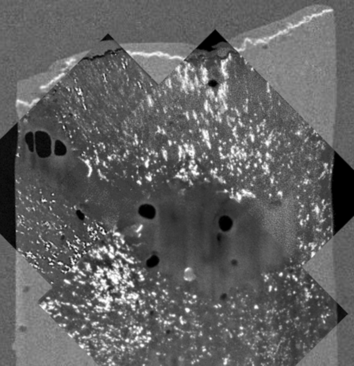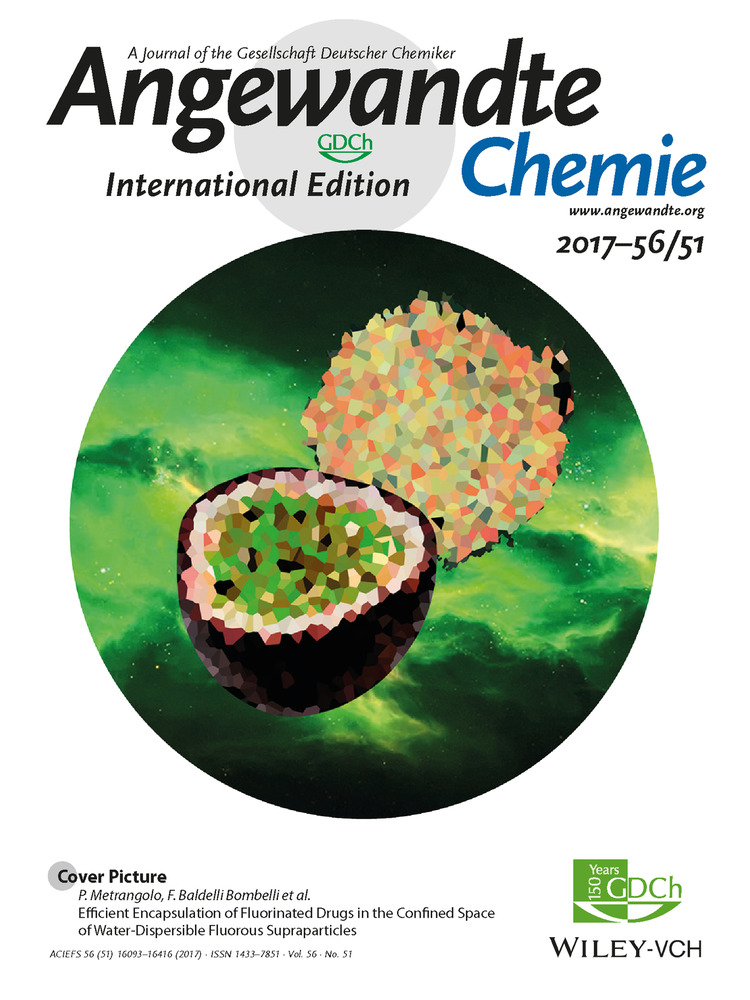High-Magnesium Calcite Mesocrystals: Formation in Aqueous Solution under Ambient Conditions
Dr. Pao-Tao Yu
Department of Chemistry, National (Taiwan) University, No. 1, Section 4, Roosevelt Road, Taipei, 10617 Taiwan
Search for more papers by this authorChieh Tsao
Department of Chemistry, National (Taiwan) University, No. 1, Section 4, Roosevelt Road, Taipei, 10617 Taiwan
Search for more papers by this authorDr. Chun-Chieh Wang
National Synchrotron Radiation Research Center, Hsinchu, 30076 Taiwan
Search for more papers by this authorChun-Yu Chang
Department of Chemistry, National (Taiwan) University, No. 1, Section 4, Roosevelt Road, Taipei, 10617 Taiwan
Search for more papers by this authorDr. Chia-Hsin Wang
National Synchrotron Radiation Research Center, Hsinchu, 30076 Taiwan
Search for more papers by this authorCorresponding Author
Prof. Dr. Jerry Chun Chung Chan
Department of Chemistry, National (Taiwan) University, No. 1, Section 4, Roosevelt Road, Taipei, 10617 Taiwan
Search for more papers by this authorDr. Pao-Tao Yu
Department of Chemistry, National (Taiwan) University, No. 1, Section 4, Roosevelt Road, Taipei, 10617 Taiwan
Search for more papers by this authorChieh Tsao
Department of Chemistry, National (Taiwan) University, No. 1, Section 4, Roosevelt Road, Taipei, 10617 Taiwan
Search for more papers by this authorDr. Chun-Chieh Wang
National Synchrotron Radiation Research Center, Hsinchu, 30076 Taiwan
Search for more papers by this authorChun-Yu Chang
Department of Chemistry, National (Taiwan) University, No. 1, Section 4, Roosevelt Road, Taipei, 10617 Taiwan
Search for more papers by this authorDr. Chia-Hsin Wang
National Synchrotron Radiation Research Center, Hsinchu, 30076 Taiwan
Search for more papers by this authorCorresponding Author
Prof. Dr. Jerry Chun Chung Chan
Department of Chemistry, National (Taiwan) University, No. 1, Section 4, Roosevelt Road, Taipei, 10617 Taiwan
Search for more papers by this authorGraphical Abstract
Abstract
Mesocrystals of high-magnesian calcites are commonly found in biogenic calcites. Under ambient conditions, it remains challenging to prepare mesocrystals of high-magnesian calcite in aqueous solution. We report that mesocrystals of calcite with magnesium content of about 20 mol % can be obtained from the phase transformation of magnesian amorphous calcium carbonate (Mg-ACC) in lipid solution. The limited water content on the Mg-ACC surface would reduce the extent of the dissolution–reprecipitation process and bias the phase transformation pathway toward solid-state reaction. We infer from the selected area electron diffraction patterns and the dark-field transmission electron microscopic images that the formation of Mg-calcite mesocrystals occurs through solid-state secondary nucleation, for which the phase transformation is initiated near the mineral surface and the crystalline phase propagates gradually toward the interior part of the microspheres of Mg-ACC.
Supporting Information
As a service to our authors and readers, this journal provides supporting information supplied by the authors. Such materials are peer reviewed and may be re-organized for online delivery, but are not copy-edited or typeset. Technical support issues arising from supporting information (other than missing files) should be addressed to the authors.
| Filename | Description |
|---|---|
| anie201708507-sup-0001-misc_information.pdf2.1 MB | Supplementary |
| anie201708507-sup-0001-Movie_3D.mpg10.1 MB | Supplementary |
Please note: The publisher is not responsible for the content or functionality of any supporting information supplied by the authors. Any queries (other than missing content) should be directed to the corresponding author for the article.
References
- 1D. Graf, Am. Mineral. 1961, 46, 1283–1316.
- 2S. Raz, S. Weiner, L. Addadi, Adv. Mater. 2000, 12, 38–42.
- 3X. Long, Y. Ma, L. Qi, J. Struct. Biol. 2014, 185, 1–14.
- 4S. Gayathri, R. Lakshminarayanan, J. C. Weaver, D. E. Morse, R. M. Kini, S. Valiyaveettil, Chem. Eur. J. 2007, 13, 3262–3268.
- 5J. Hermans, L. André, J. Navez, P. Pernet, P. Dubois, J. Geophys. Res. Biogeosci. 2011, 116, G 01001.
- 6J. W. Xiao, S. H. Yang, CrystEngComm 2011, 13, 2472–2478.
- 7N. Wada, K. Yamashita, T. Umegaki, J. Colloid Interface Sci. 1999, 212, 357–364.
- 8F. C. Meldrum, S. T. Hyde, J. Cryst. Growth 2001, 231, 544–558.
- 9X. G. Cheng, P. L. Varona, M. J. Olszta, L. B. Gower, J. Cryst. Growth 2007, 307, 395–404.
- 10A. Xie, Y. Shen, X. Li, Z. Yuan, L. Qiu, C. Zhang, Y. Yang, Mater. Chem. Phys. 2007, 101, 87–92.
- 11A. E. Stephenson, J. J. DeYoreo, L. Wu, K. J. Wu, J. Hoyer, P. M. Dove, Science 2008, 322, 724–727.
- 12D. B. Wang, A. F. Wallace, J. J. De Yoreo, P. M. Dove, Proc. Natl. Acad. Sci. USA 2009, 106, 21511–21516.
- 13X. Long, Y. Ma, L. Qi, Cryst. Growth Des. 2011, 11, 2866–2873.
- 14Y.-Y. Wang, Q.-Z. Yao, G.-T. Zhou, S.-Q. Fu, Eur. J. Mineral. 2015, 27, 717–729.
- 15Y. Politi, T. Arad, E. Klein, S. Weiner, L. Addadi, Science 2004, 306, 1161–1164.
- 16S. Bentov, S. Weil, L. Glazer, A. Sagi, A. Berman, J. Struct. Biol. 2010, 171, 207–215.
- 17W. J. E. M. Habraken, A. Masic, L. Bertinetti, A. Al-Sawalmih, L. Glazer, S. Bentov, P. Fratzl, A. Sagi, B. Aichmayer, A. Berman, J. Struct. Biol. 2015, 189, 28–36.
- 18P. J. M. Smeets, K. R. Cho, R. G. E. Kempen, N. A. J. M. Sommerdijk, J. J. De Yoreo, Nat. Mater. 2015, 14, 394–399.
- 19G. Falini, M. Gazzano, A. Ripamonti, Chem. Commun. 1996, 1037–1038.
- 20J. J. M. Lenders, A. Dey, P. H. H. Bomans, J. Spielmann, M. M. R. M. Hendrix, G. de With, F. C. Meldrum, S. Harder, N. A. J. M. Sommerdijk, J. Am. Chem. Soc. 2012, 134, 1367–1373.
- 21J. Xu, C. Yan, F. Zhang, H. Konishi, H. Xu, H. H. Teng, Proc. Natl. Acad. Sci. USA 2013, 110, 17750–17755.
- 22J. Jiang, M.-R. Gao, Y.-H. Qiu, G.-S. Wang, L. Liu, G.-B. Cai, S.-H. Yu, CrystEngComm 2011, 13, 952–956.
- 23C. R. Blue, P. M. Dove, Geochim. Cosmochim. Acta 2015, 148, 23–33.
- 24H. Yang, S. Chai, Y. Zhang, Y. Ma, CrystEngComm 2016, 18, 157–163.
- 25B. Purgstaller, V. Mavromatis, A. Immenhauser, M. Dietzel, Geochim. Cosmochim. Acta 2016, 174, 180–195.
- 26C. R. Blue, A. Giuffre, S. Mergelsberg, N. Han, J. J. De Yoreo, P. M. Dove, Geochim. Cosmochim. Acta 2017, 196, 179–196.
- 27B. Purgstaller, F. Konrad, M. Dietzel, A. Immenhauser, V. Mavromatis, Cryst. Growth Des. 2017, 17, 1069–1078.
- 28F. C. Meldrum, H. Colfen, Chem. Rev. 2008, 108, 4332–4432.
- 29H. Cölfen, M. Antonietti, Angew. Chem. Int. Ed. 2005, 44, 5576–5591; Angew. Chem. 2005, 117, 5714–5730.
- 30L. Bergström, E. V. Sturm (née Rosseeva), G. Salazar-Alvarez, H. Cölfen, Acc. Chem. Res. 2015, 48, 1391–1402.
- 31Y.-Y. Kim, A. Schenk, J. Ihli, A. Kulak, N. Hetherington, C. Tang, W. Schmahl, E. Griesshaber, G. Hyett, F. Meldrum, Nat. Commun. 2014, 5, 4341.
- 32K. Chave, J. Geol. 1952, 60, 190–192.
- 33M. C. Nash, B. N. Opdyke, Z. Wu, H. Xu, J. M. Trafford, J. Sediment. Res. 2013, 83, 1085–1099.
- 34M. Donnet, A. Aimable, J. Lemaître, P. Bowen, J. Phys. Chem. B 2010, 114, 12058–12067.
- 35J. Ihli, W. C. Wong, E. H. Noel, Y.-Y. Kim, A. N. Kulak, H. K. Christenson, M. J. Duer, F. C. Meldrum, Nat. Commun. 2014, 5, 3169.
- 36Z. Zou, L. Bertinetti, Y. Politi, A. C. S. Jensen, S. Weiner, L. Addadi, P. Fratzl, W. J. E. M. Habraken, Chem. Mater. 2015, 27, 4237–4246.
- 37F. Konrad, F. Gallien, D. E. Gerard, M. Dietzel, Cryst. Growth Des. 2016, 16, 6310–6317.
- 38Y. Politi, R. A. Metzler, M. Abrecht, B. Gilbert, F. H. Wilt, I. Sagi, L. Addadi, S. Weiner, P. U. P. A. Gilbert, Proc. Natl. Acad. Sci. USA 2008, 105, 17362–17366.
- 39C. C. Tester, M. L. Whittaker, D. Joester, Chem. Commun. 2014, 50, 5619–5622.
- 40P. Wan, Y. Zhao, H. Tong, Z. Yang, Z. Zhu, X. Shen, J. Hu, Mater. Sci. Eng. C 2009, 29, 222–227.
- 41A. Szcześ, Colloids Surf. B 2013, 101, 44–48.
- 42L. J. Lis, W. T. Lis, V. A. Parsegian, R. P. Rand, Biochemistry 1981, 20, 1771–1777.
- 43C. Altenbach, J. Seelig, Biochemistry 1984, 23, 3913–3920.
- 44C. G. Sinn, M. Antonietti, R. Dimova, Colloids Surf. A 2006, 282, 410–419.
- 45P. Bots, L. G. Benning, J.-D. Rodriguez-Blanco, T. Roncal-Herrero, S. Shaw, Cryst. Growth Des. 2012, 12, 3806–3814.
- 46F. Lippmann, Sedimentary Carbonate Minerals, Springer, Berlin, 1973.
10.1007/978-3-642-65474-9 Google Scholar
- 47J. D. Rodriguez-Blanco, S. Shaw, P. Bots, T. Roncal-Herrero, L. G. Benning, Geochim. Cosmochim. Acta 2014, 127, 204–220.
- 48J. Ni, G. Zhou, Earth Sci. Front. 2008, 15, 83–89.
- 49P. J. Heaney, E. P. Vicenzi, L. A. Giannuzzi, K. J. T. Livi, Am. Mineral. 2001, 86, 1094–1099.
- 50J. Bolze, B. Peng, N. Dingenouts, P. Panine, T. Narayanan, M. Ballauff, Langmuir 2002, 18, 8364–8369.
- 51E. Sturm née Rosseeva, H. Cölfen, Chem. Soc. Rev. 2016, 45, 5821–5833.
- 52C. E. Killian, R. A. Metzler, Y. U. T. Gong, I. C. Olson, J. Aizenberg, Y. Politi, F. H. Wilt, A. Scholl, A. Young, A. Doran, et al., J. Am. Chem. Soc. 2009, 131, 18404–18409.
- 53S. Weiner, L. Addadi, Annu. Rev. Mater. Res. 2011, 41, 21–40.
- 54E. Loste, R. M. Wilson, R. Seshadri, F. C. Meldrum, J. Cryst. Growth 2003, 254, 206–218.
- 55J. Seto, Y. R. Ma, S. A. Davis, F. Meldrum, A. Gourrier, Y. Y. Kim, U. Schilde, M. Sztucki, M. Burghammer, S. Maltsev, et al., Proc. Natl. Acad. Sci. USA 2012, 109, 3699–3704.





